🚀 History & Milestones
- 2001: Dennis Tito is the first space tourist, paying ~$20 M for an 8‑day visit to the ISS through Russian Soyuz .
- 2004: SpaceShipOne captures the Ansari X‑Prize, paving the way for commercial suborbital flights .
- 2021: Significant milestones:
- Blue Origin’s New Shepard takes Jeff Bezos, Wally Funk, and 18‑year‑old Oliver Daemen .
- Virgin Galactic takes Richard Branson and two women crew members .
- SpaceX makes its first fully private orbital flight with Axiom Space.
🚀 Types of Space Tourism
🛫 Suborbital Flights
- Short flights above the Kármán line (~100 km altitude) with a few minutes of weightlessness.
- Operators include:
- Blue Origin New Shepard: reusable vertical launch system for up to 6 passengers .
- Virgin Galactic’s SpaceShipTwo: air-launched from WhiteKnightTwo, providing 6–7 min of zero‑G .
🌍 Near-space Balloon Rides
- High-altitude balloons to ~30–36 km (stratosphere). Provides panoramic Earth views without entering orbit:
- Space Perspective’s Spaceship Neptune: 2-hour balloon gondola ascent.
- World View and Zero 2 Infinity also provide comparable trips .
🛰️ Orbital & ISS Visits
- Short stays in Low Earth Orbit or spacewalks; highly immersive experiences:
- Space Adventures organized NASA-associated ISS flights early in the 2000s .
- SpaceX Crew Dragon & Axiom flights have been providing 7+ day ISS flights, at up to ~$55 M .
🌕 Beyond LEO: Lunar Flybys & Mars
- SpaceX is planning private lunar flights on Starship, albeit still conceptual.
🧭 Industry Size & Growth
- Global space tourism market: ~$1.3 B (2024), to $6.7 B by 2030 (CAGR ~31.6%) .
- Orbital and lunar travel are projected to rise faster than suborbital flights currently dominate .
- North America is leading (~60% share), with Asia-Pacific (China and India) as rapidly growing markets .
💸 Costs & Requirements
- Suborbital flights: $200K–$500K (Virgin Galactic, Blue Origin) .
- Orbital/ISS missions: $28 M–$55 M per seat .
- Stratospheric balloon: ~$495K dinner-plus-ride package.
- Requirements: Medical check-ups, cardiovascular & bone-density screening; pre-flight training (simulators, zero-G, emergencies).
🌍 Benefits & Challenges
- Benefits:
- Drives tech breakthroughs (reusable rockets, life support) .
- Inspires STEM interest and global perspective through the “overview effect” .
- Boosts economic growth, creates high-skilled jobs .
- Challenges:
- Safety remains paramount—risks in launch, re-entry, hardware malfunctions .
- High ticket prices restrict access; durability as mainstream tourism is unproven .
- Environmental concerns: emissions, space debris .
- Legal & regulatory frameworks are still evolving globally .
✨ New Entrants & Unique Experiences
SpaceVIP’s “Space Dining” at Edge of Space
- SpaceVIP (created by Roman “Mr Intergalactic” Chiporukha) is planning a 6-hour gourmet meal journey on a pressurized stratospheric capsule from Kennedy Space Center.
- The prices are set at approximately US $495,000 per person. Travelers are provided with panoramic vistas, onboard Wi‑Fi, and livestreaming features—intended to democratize space travel in the long run.
🚀 Axiom Space Gains Massive Funding & Partners
- Axiom Space recently raised hundreds of millions, valuing it at around $2 billion. The funds fund its plans to develop the first commercial space station .
- Milestones involve 12 astronaut missions to the ISS to date, with larger ships on the way (12–24 individuals) and bespoke spacesuits (even partnering with Prada).
- Notably, Axiom inked a MoU with India’s Skyroot Aerospace in June 2025 to widen access to LEO by integrating Skyroot’s Vikram-1 launch vehicle and Axiom’s future station initiatives.
🎈 Balloon-Based Near-Space Experience
Space Perspective’s Neptune Capsule Updates
- Spaceship Neptune will take 8 adventurers and a pilot to ~100,000 ft aboard a hydrogen-filled SpaceBalloon™, providing a rocket-free, carbon-free climb.
- The Excelsior test capsule (16 ft diameter, ~2,000 cu ft volume) cleared major uncrewed flight tests in Sept 2024—did it reach 100,000 ft and sustain cabin pressure and temperature control.
- In spite of robust growth and ticket purchase (~1,600 seats), the firm encountered financial difficulties in early 2025, such as unpaid rent and eviction notices—rendering its commercial prospects uncertain as of April 2025 .
🌍 Global Market: Rising Competition
China-based Deep Blue Aerospace intends to offer suborbital flights by 2027, with tickets from ~¥1.5 million (~US $211K), using reusable rockets for cost-effectiveness—paralleled by initiatives from other companies like CAS Space targeting launches by 2028.
🔭 Concepts on the Horizon
- Hilton Starlab: A 4-person private orbital habitat sponsored by NASA and ESA, planned for deployment by 2028 through SpaceX’s Starship .
- Voyager Station: By Above: Space Development Corp, this conceptual rotating space resort has the potential to welcome 400 visitors in artificial gravity. Still in its infancy, but planned for sometime in the latter part of the decade.
- Orbital Reef: A Blue Origin–financed LEO business park financed by NASA, with giant windows and modular living quarters—targeting late 2020s launch.
🌟 In Summary
Space tourism these days encompasses suborbital thrill rides, stratospheric balloon flights, and complete orbital flights. Industry leaders such as Virgin Galactic, Blue Origin, SpaceX, and Space Perspective are expanding the boundaries. Though prices are still high and hurdles massive, the industry is on track for explosive expansion in the decade to come—envisaging technological progress, economic development, and even a new era of space accessibility.



